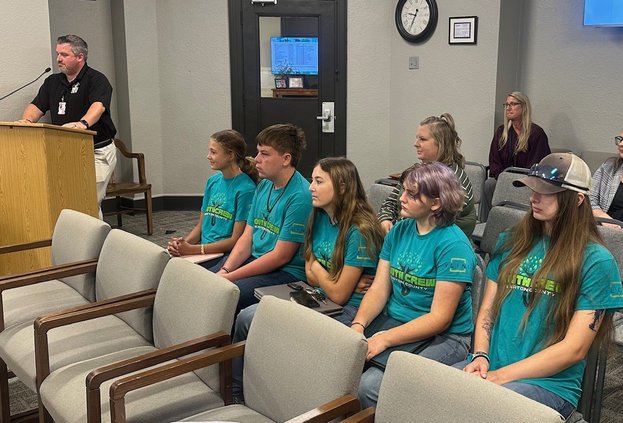BY KEITH LIPPOLDT
klippoldt@gbtribune.com
Five Barton County teenage students and two sponsors made their way to Nashville, Tenn., from July 20-24 for the Community Anti-Drug Coalitions of America (CADCA) Mid-Year Training Institute. The CADCA training program is “where professionals from across the substance use prevention field come together for four days of hands-on workshops, insights from experts, and networking opportunities. This event brings together industry leaders, master trainers, coalition members, and CADCA staff to share the latest cutting-edge strategies, best practices, and innovative solutions to common challenges.”
The four-day intense training session is designed for seasoned professionals and newcomers alike. This event offers a chance to expand your knowledge, add to your skillset, and collaborate with like-minded peers. You’ll leave with practical tools and fresh ideas to help drive change in your community.
Tyler Morton, Prevention Advocate with Juvenile Services, and Nichelle Holinde from the Family Crisis Center, who is a Youth Crew stakeholder member and mother of a Youth Crew member, were tasked with the responsibilities of getting the crew members to and from Nashville and mentoring them throughout the week. The Youth Crew members that attended the training were Mya Brewer, Branson Holinde, Brooklyn Cooley, Janey Weber and Matilda Philbern.
“The goal of Youth Crew-Barton County is to provide prevention education and resources to teens in our area,” Morton said. “Our program is for 6th-12th grade students in Barton County. The substances we are trying to help them avoid are alcohol and marijuana, as per our grant. With that being said, we understand that those substances, along with many other substances and overall general peer pressures, all play a role in the lives of our young people. By providing prevention education, we can help skew the number of young people getting involved with wrong things and redirect them back to positive, pro-social activities.”
Last year when they were traveling to Chicago, the group encountered two tornadoes and had hotel complications. Morton said they had one issue on the trip this year.
“I think probably the worst thing that happened to us on the way out there was we were all excited and pumped to get some Chick-fil-A when we left. And then about an hour into our trip, we realized that it was Sunday that we were traveling on. So that was a little disappointing.”
There are two levels of training. The first-time attendees, Janey Weber and Matilda Philberg, were in the early training track called Key Essentials. Morton explained that’s essentially where they get everything they need to learn about prevention right out the gates.
“The CADCA Mid-Year trip is the pinnacle of training for our youth leaders,” Morton said. “It is four days of intense training, all the way from the foundation principles of prevention to specific topic matters such as sustainability and finding sector representation. We can only teach so much during our once-a-month meetings here in Barton County. With our youth having footing on topics, and then getting a bulk training at one time, that really helps them understand concepts.
“It’s a lot of notetaking. It’s long days. It’s really immersed in trying to learn just the foundation of prevention. I know they have binders full of notes. There was a workbook that they were filling out as well. I’m so proud of them for that, proud of them for stepping out of their shells a little bit. And to have to do public speaking and to have to do just general engagement, that’s a big ask and so I think they did a wonderful job with that.”
The students that were making their second appearance at the training attended different classes but, too, stayed busy nine hours a day. Mya Brewer, Brooklyn Cooley and Branson Holinde were in “Youth Leader Groups with Breakout Sessions.” The sessions they attended were “How to Ask for Sponsorships, Event Planning and the Roles of Planning,” as well as “The 12 Sectors.”
“For the three that have been before, I think probably my biggest takeaway for them is that I got a lot of good compliments on them, not only from some of the other youth coalitions that were there and their advisors, but from the CADCA team,” Morton said. “And I know that a bunch of the trainers recognized them. So these are people that we see maybe once or twice a year. And for them to know them by name or remember them by name, I think it speaks volumes to the work that they’re doing, the attention that they’re paying.”
Nichelle Holinde, who shadowed the veterans, also had nothing but positives to say about the group.
“Last year they were kind of shy. This year they were everything but shy,” she said. “In the classes, they were first to raise their hands, they cooperated and participated in everything. Had talks with other students in auditions, so it was really cool to see them grow in just one year.”
Morton found another positive in the conference.
“There is also something to be said for the fact that our group is just a little over 30 students currently. When we attend a conference like this, there are thousands of students that ours get to interact with and learn from. On topics that are relevant to our area but maybe are not focal points for Barton County specifically, our youth get training in those matters as well because of the diversity of being surrounded by so many other peers. Not to mention that it helps greatly with their public speaking and presentation skills.”
Youth Crew Takeaways
Mya Brewer — “One of the main things that stuck out to me and that I learned is the 12 sectors of a drug-free community. That basically just means all 12 sectors of a community coming together in order to have a substance-free community, especially with youth. The 12 are youth, parents, business, media, school, youth service organizations, law enforcement, civic/volunteer organizations, religious organizations, health care professionals, state, local and tribal government, and substance abuse organizations. All of these sectors have purpose and a substance for your community. But it’s our job as a coalition to make sure they know how to raise awareness on this.”
Branson Holinde — “The thing I’m going to be talking about today is different types of roles in people in the coalition and like events because all these go together to make the event fun.”
Holinde listed the different roles as “Life of the party,” who makes everyone feel at ease. Next was the “Runner,” the person that makes the event run smoothly. The “Creative” makes things look good and very creative. The “Game Master,” facilitates any games or competitions going on at the event. And then there are the others, including tear-down, sponsor/coordinator, cup crew and music master.
Brooklyn Cooley — “One of the biggest things that I brought back was asking for a sponsorship. First we needed to think of what people would like to see at your eight minute example. Ask for a sponsor. Second thing is to find out how much you’re asking for. Third, don’t ever go alone — find someone to go with you, The fourth thing was always ask for double of what you actually need, whether it’s money or product. Fifth is to explain to the sponsor what their company can do for their event. Tell them how you will show their company and when they say ‘yes,’ thank the sponsor and come back to your event and do what it is needed to show the company, but also show why you chose that company.
Janey Weber — “One of the things that I brought back were the ‘Seven Cs of Leadership,’ which is basically what personality traits the leadership have.”
She listed the Cs as consciousness, congruence, commitment, collaboration, common purpose, controversy with civility, and citizenship.
Matilda Philbern — “I did one about the games so we could do team bonding to where we could learn more about each other and be more comfortable talking around each other.”
After the presentations, the Commissioners had words for the Youth Crew members.
Commissioner feedback
“I’m just so proud of you guys,” Commissioner Donna Zimmerman said. “I think it’s hard to participate in these kinds of events, and I’m glad that you guys put yourself out here to do that. And coming in here isn’t easy to do. I really appreciate you guys. You guys are wonderful kids and we wish you the best.”
Commissioner Shawn Hutchinson challenged them to put their new knowledge to work.
“I was just going to say, Maya, Branson, Brooklyn, Janey, and Matilda, you guys have a big responsibility now to take what you’ve learned, and share that with your friends. Your friends didn’t get to go do that, so now you guys have to help them if you see somebody having trouble with social media or whatever they’re having troubles with, it is part of being a leader to help your friends. I bet you guys can do that.”





